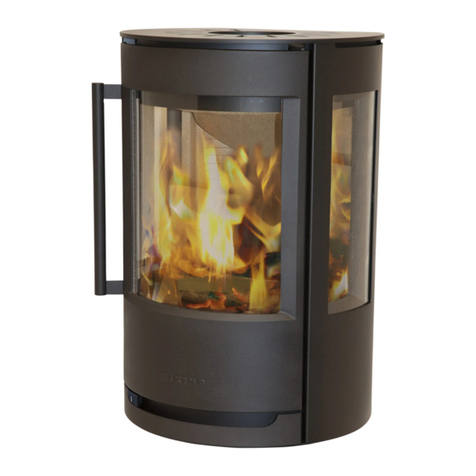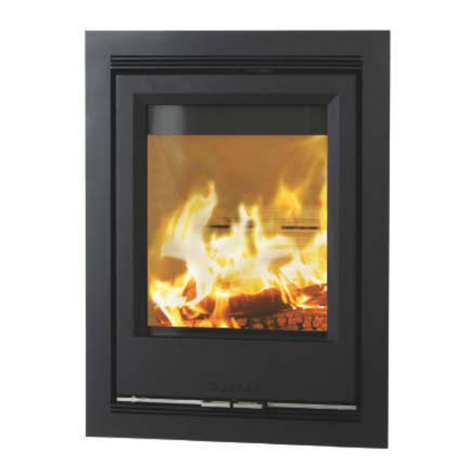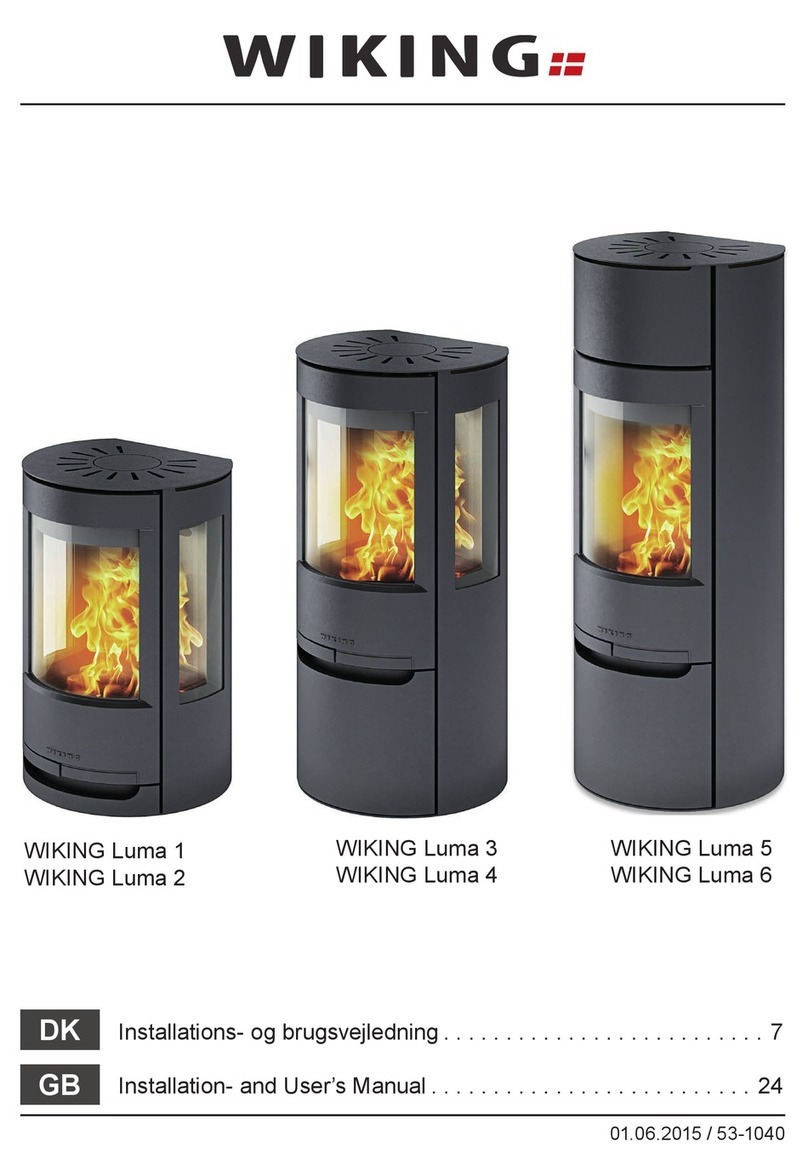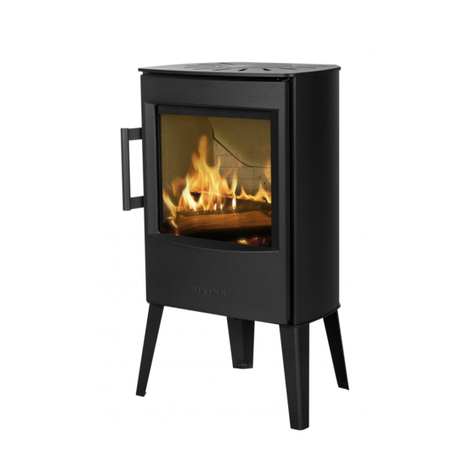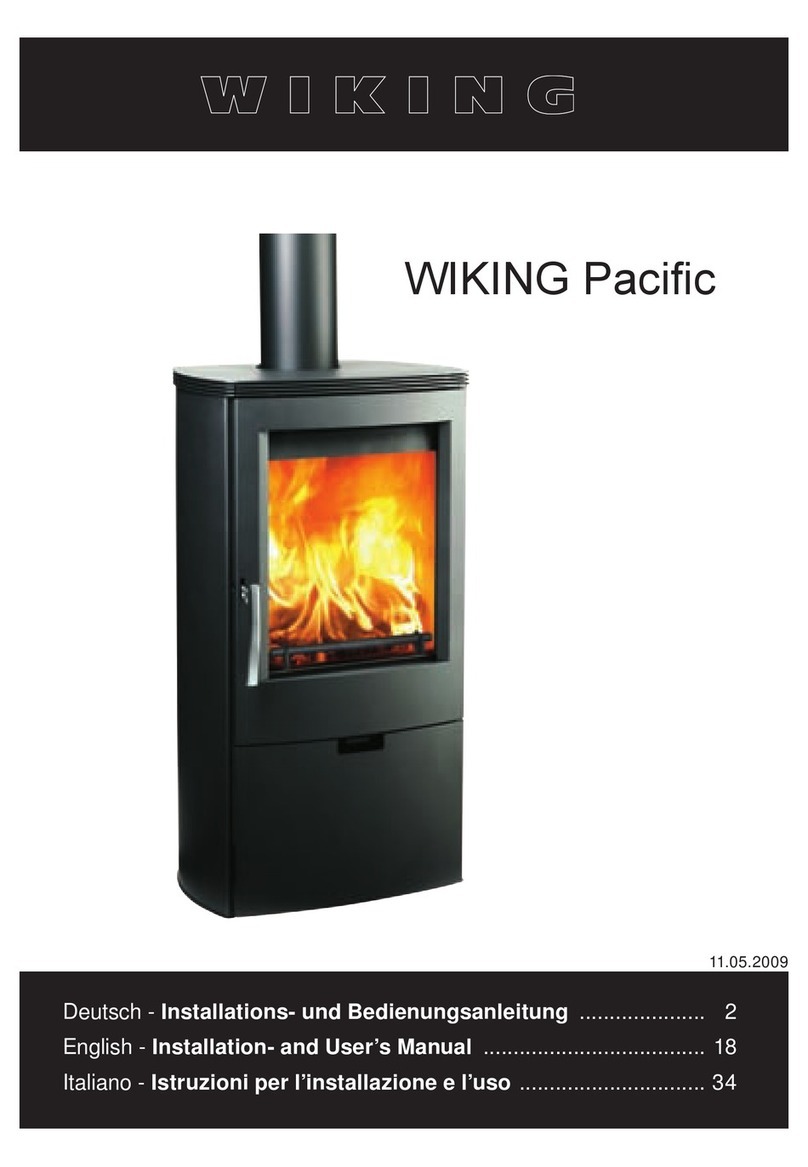wiking Mini 2 User manual

01.11.2020 / 53-077-2
Installation- and User’s Manual
made by
EN
WIKING Mini 2

Contents
Drawings ............................................................................................................3-6
Installation ............................................................................................................. 8
Firing manual - wood........................................................................................... 13
Firing in general .................................................................................................. 16
Maintenance........................................................................................................ 17
Declaration of Performance ................................................................................ 19
Product informaiton EcoDesign .......................................................................... 20
Trouble Shooting ................................................................................................. 22
......................................................................................... 24

Page 3 of 24 pages
A
B

Page 4 of 24 pages
C
D1

Page 5 of 24 pages
D3
D2

Page 6 of 24 pages
2
1
E

Page 7 of 24 pages
.

Page 8 of 24 pages
In general
Congratulations on your new WIKING woodburning stove. We are pleased that you have cho-
optimum operation and safety, we recommend that the installation should be carried out by an
retailers, visit www.wiking.com under “Retailer locations”.
Safety
The installation of your WIKING woodburning stove must always comply with all European,
national and local building regulations. The installation must be carried out in accordance with
the instructions in the installation and user manuals and subsequently registered with the local
authorities. Upon installation, the chimney sweep must approve the installation before you can
start using the woodburning stove. All WIKING woodburning stove packaging material must be
handled in accordance with local waste management regulations.
Room requirements
Always ensure a supply of fresh combustion air to the room where the stove is to be installed.
The woodburning stove uses approx. 7-16 m3 of air per hour. A window that can be opened
valve/grate. In newly built/airtight dwellings, we recommend that a fresh air system should be
installed for the direct supply of external air to the combustion. This fresh-air system may be
bought separately.
withstand the weight of the stove and the chimney. The weight of the chimney should be cal-
culated according to its dimensions and height.
Technical measures and data
Test results from nominal test EN 13240
4.5 kW
Flue gas temperature EN 13240 measurement point 236ºC
Flue gas temperature measured in the outlet socket 283ºC
3.6 g/s
83 %
73 %
PM 6 mg/m3
OGC 84 mg/m3
NO299 mg/m3
CO at 13% O2881 mg/m3
CO at 13% O20.0705 %
110
A+
Test result based on NS 3058
Particle emissions 1.86 g/kg

Page 9 of 24 pages
Norsk
Model Weight Height Width Dept
Mini 2 with base 72.1 kg 60.8 cm 46.8 cm 35.6 cm
Mini 2 with low legs 72.0 kg 65.2 cm 46.8 cm 35.6 cm
Mini 2 with high legs 73.5 kg 68.4 cm 51.3 cm 37.1 c m
Floor plate
European, national and local regulations must be observed in terms of the size and thickness
your WIKING retailer for assistance. The combustion chamber opening is 35.0 cm wide.
Distance to combustible materials
Min. distances
- uninsulated ue gas pipe:
WIKING Mini 2
with base
WIKING Mini 2
with low legs
WIKING Mini 2
with high legs
- insulated ue gas pipe:10 cm 10 cm 10 cm
Recommended for brick wall, side 10 cm 10 cm 10 cm
For combustible wall, back 12.5 cm 12.5 cm 12.5 cm
For combustible wall, side 32.5 cm 32.5 cm 32.5 cm
To combustible wall,
corner installation, 45º
7.5 cm 7.5 cm 7.5 cm
stove
22* cm 22* cm 22* cm
Distance to furnishings in front 100 cm 100 cm 100 cm
* This distance requirement is met if the stove is installed with high legs or on a wall with the required distance below the wood-burning stove
Min. distances
- insulated ue gas pipe:
WIKING Mini 2
with base
WIKING Mini 2
with low legs
WIKING Mini 2
with high legs
Recommended for brick wall, back 10 cm 10 cm 10 cm
Recommended for brick wall, side 10 cm 10 cm 10 cm
For combustible wall, back 7.5 cm 7.5 cm 7.5 cm
For combustible wall, side 32.5 cm 32.5 cm 32.5 cm
To combustible wall,
corner installation, 45º
5 cm 5 cm 5 cm
stove
22* cm 22* cm 22* cm
Distance to furnishings in front 100 cm 100 cm 100 cm
* This distance requirement is met if the stove is installed with high legs or on a wall with the required distance below the wood-burning stove
IMPO RTANT:
Combustible materials may not be placed under the stove.
WIKING Mini with a base and WIKING Mini with short legs must not be mounted on
combustible oors. It is still considered a combustible oor even if an ember catching,
non-combustible oor plate is placed on top of the combustible oor.
A non-combustible structure under WIKING Mini with a base and low legs must extend
at least 400 mm in front of the stove.

Page 10 of 24 pages
Remember to pay attention to the applicable regulations concerning the required distance
between the wall and smoke pipe.
Please be aware that not all glass parts are heat-resistant. For this reason, a glass wall should
sometimes be treated as a combustible wall, in which case we ask you to contact your local
chimney sweep or glass producer to hear at what distance the stove should be kept from glass.
Requirements for chimney and smoke pipe
As a general rule, satisfactory draught conditions are achieved if the chimney is 4 m above
the stove and at least 80 cm above the ridge. If the chimney is placed at side walls, the top of
the chimney should always be higher than the ridge or the tallest point of the roof. Always be
aware of any national and/or local regulations applying to thatched roofs and the location of
the chimneys.r.
-
18-20 Pa.
The chimney must have a minimum clearing of Ø 125 mm or Ø 150 mm. The chimney must be
-
cordance with the brand label. Ask your WIKING retailer for further information.
Changing the Smoke Outlet from Top Outlet to Back Outlet
Proceed as follows to change the smoke outlet from top outlet to rear outlet:
5. Install the cover plate on top of the stove with the three screws.
6. Place the smoke ring in the smoke outlet hole in the back of the stove and secure it with the
three screws.
7. Replace the top plate on the stove.
A top cover can be bought as an accessory to cover the hole in the top plate of the stove if the
stove is connected to a rear smoke outlet.
A top cover can be bought as an accessory to cover the hole in the top plate of the stove
if the stove is connected to a back smoke outlet.
Connection to chimney
All the stoves have both back and top smoke outlet that can be connected to an approved steel
chimney on top or directly out at the rear to a chimney.
Make sure that the chimney is tight and that no false draft is caused around neither the cover
plate, in connection with a covered smoke outlet, nor the cleanout door and pipe connections.

Page 11 of 24 pages
3. Vermiculite rear plate.
4. Vermiculite corner plate.
5. Vermiculite side plate.
6. Bottom plate
7. Protection during transportation
8. Fittings
Please note: The combustion chamber is covered with plates made of vermiculite, which is a
heat-insulating material. These plates ensure that the optimal combustion temperature is quickly
reached, and they must therefore remain inside in the wood-burning stove.
their warmth within the stove and the surrounding area. In this way you get more warmth from
the wood you add to the stove, as the warm smoke is not simply sent out through the chimney.
Fitting the loose parts
that all insulation plates of the combustion chamber have been properly placed, i.e. that the
bottom plate is horizontal and that the side plates are vertical and reach all the way up to the
steel sides of the combustion chamber and down to the bottom plate.
1.
as protection during transportation. Remember to remove the two pins before you start us-
ing the stove.
2.
of the combustion chamber and must be pushed as far back as possible into the combus-
tion chamber.
3.
4.
Chimney
The chimney is the “engine” of the stove and it is crucial for the functioning of the woodburning
stove. The chimney draft provides a partial vacuum in the stove. This vacuum removes the
smoke from the stove, sucks air through the dampers for the so-called glass pane rinse which
keeps the glass free of soot, and sucks in air through both primary and secondary dampers
for the combustion.
The higher the temperature within the chimney, the greater the draft. It is crucial, therefore, that
the chimney is warmed up properly before closing the damper and limiting the combustion in the
On days where the wea-

Page 12 of 24 pages
If the stove has not been used for a longer period, it is important to check that the chimney pipe
is not blocked.
check the applicable rules.
Chimney sweeping
the chimney is too tall to be cleaned from above, it must be equipped with a soot door.
have the chimney checked by the chimney sweeper.

Page 13 of 24 pages
Your first heating session
The lacquer will be fully hardened after the stove has been used, and the door and the ashpan
should be opened very carefully as there will otherwise be a risk that the gaskets will stick to
that the room is well ventilated.
Warning:
Tips about fuel
Approved fuel types
The wood burning stove is EN approved for combustion of wood only. It is recommended to
Recommended wood types
All types of wood, for instance birch, beech, oak, elm, ash, conifers, and fruit trees can be used
types per cubic metre. Beech weighs more per m3of wood than common spruce, for instance.
This is why more common spruce is required, in terms of volume, to obtain an amount of heat
similar to that of beech. Heavy types of wood such as ash, beech, oak and elm are generally not
wood such as birch, maple, spruce and pine are more easy to light up. They burn faster and give
the heavier types of wood to ensure a longer burning time..
Banned fuel types
fuels, and rubbish such as milk cartons, lacquered wood or impregnated wood and fossil fuels.
The reason that you should not apply any of the above is that during combustion they develop
substances that are health hazardous and harmful to the environment. These substances
could also damage your wood burning stove and chimney, rendering the product warranty
void.
Storage of wood
A moisture content of 12-18% is achieved by storing recently felled wood outdoors under a
lean-to for at least one year, preferably 2 years. Wood stored indoors has a tendency to be-
come too dry and combust too quickly. However, it might be advantageous to store fuel for
Split the wood and measure the mois-
ture content of the split surfaces.
Recommended dimensions
The dimensions of the fuel are important to good combustion. The dimensions should be as

Page 14 of 24 pages
Norsk
follows:
Fuel type Length in cm Diameter in cm
16-28 2-4
Chopped wood 16-28 6-9
Using the Air Damper
located under the stove door; see drawing D.
When lighting a cold stove and when fuellingwith new wood, the regulating lever must be pu-
air supply can be gradually reduced by moving the regulating lever to the right.
stove has been allowed to go out completely in connection with cleaning, for instance.
Lighting the stove
A successful combustion process requires that the wood is lit in the right way. A cold stove
and a cold chimney challenge the combustion process. Be careful to make a good lighting with
Move the air control lever to the extreme left to fully open the air supply to
air supply can be gradually reduced by moving the air control lever to the right until uniform,
steady combustion is achieved.
Important! The ash pan must not be opened during the lighting stage and must always be
kept closed when the stove is lit or the WIKING®Automatic™ might be damaged. Only open
the door when lighting the stove, refuelling it and cleaning it. Never leave a stove before there
Stoking
layer of embers is suitable when the pieces of wood begin to disintegrate and the bottom of the
stove is covered by embers. Carefully open the door to prevent smoke and embers from esca-

Page 15 of 24 pages
“initiator”, which is not the purpose of the air. Close the door again and fully open the air supply
air supply can be gradually reduced by moving the air control lever to the right until uniform,
steady combustion is achieved. The further to the right the air control lever is moved, the less
During combustion, the outer surfaces of the stove will become hot, and due care must
therefore be shown.
When burning is complete
When the stove is not in use, turn the air control lever all the way to the right.
Cleaning the glass
Fuelling with coal or pet coke
The stove is not approved to use coal or pet coke as a fuel.

Page 16 of 24 pages
Rapid or erce heat
Maximum amounts of fuel:
The maximum allowed amount of fuel per hour is:
Wood: 2,4 kg
If these limits are exceeded, the stove will no longer be covered by the factory guarantee, and
it may also become damaged due to excessive heat, the glass may turn white, for example..
The stove has been approved for intermittent use.
The EN test is performed with 2 logs, both with a length of 16 cm, cross-section approximately
7.5 x 7.5 cm placed in vermiculite back plate to door orientation. It is burned with the air control
Typical re-ring interval
Prolonged burning time
active, the air intake can be adjusted further down.
How to achieve the best combustion
• Use clean and dry wood
heat will dry the wood, not heat up the room.
• The re should only be stoked with a little wood at a time
you achieve a good combustion.
• Make sure there is the right amount of air
temperature in the wood burning stove climbs quickly. In this way the gasses and particles
• Don’t savour the re during night time
an attempt to still have some embers left in the morning. If you do so, large amounts of
hazardous smoke will be emitted, and your chimney will be exposed to unnecessarily large

Page 17 of 24 pages
Cleaning
Any maintenance of the stove should only be carried out when it is cold. Daily maintenance is
dust the stove using a dry, soft cloth or brush. But remember, only when the stove is cold. Do
not use water, spirit or any other kind of cleaner, as this will damage the lacquer.
Once a year, the stove should be thoroughly serviced. The combustion chamber should be
cleared of ashes and soot. The hinges and the closing hook must be greased with liquid cop-
onto the hinge leaf.
Service inspection
• Thorough cleaning of the stove.
• Checking the spring in the WIKING®Automatic™. Replace if necessary.
• Checking gaskets. Replace gaskets if they are not intact or are no longer soft.
• Checking and/or replacing insulation material.
• Checking the combustion chamber base.
• Use copper grease for hinges and locking hooks
Inside cleaning
Before chimney sweeping can be performed, the air control lever must be set to its minimum
position to prevent soot and ash from entering the WIKING®Automatic™. Unless the safety
First remove ash and soot from the combustion chamber. In drawing
C you can see which plates are found inside the combustion chamber. Carefully remove the
vermiculite plates, one after the other, in the following sequence:
2. Rear plate
3. Left corner plate
4. Right corner plate
5. Left side plate
6. Right side plate
After cleaning, carefully put the vermiculite plates back in place in the reverse order starting
with the rear plate.
Ashes
It is easiest to empty the ash pan by pulling a plastic bag over it, turning it upside down and
then carefully removing it from the bag. Ashes are disposed of via the domestic waste col-
lection.
Please note that there may be embers in the ashes for up to 24 hours after the re has
gone out!

Page 18 of 24 pages
Insulation
-
plate can cause secondary air to become incorrectly distributed in the combustion chamber,
and it should therefore be replaced. However, it should be replaced, if there are actual holes
than half its original thickness.
WIKING®Automatic™ (drawing D1-D3)
The spring in the WIKING Automatic™ should be controlled at least once every second year.
-
On a cold stove, the starting
point of the feeler is controlled. The starting point on a cold stove is about 100 above horizontal.
It should feel easy going and bouncy when you push it, no matter if the stove is cold or hot.
Mount the rear plate, the side plates and the top plate again.
Door/glass
A sooty glass door can easily be cleaned with a piece of moist kitchen roll dipped in ash. Go
should also ensure that air gaps in the door frame are free of ash and soot particles.
Seals
Check frequently to ensure that seals in the door and ash pan are intact and not brittle. Failing
this, they should be replaced. Use original seals only.
Surface
Usually, it is not necessary to any treatment to the painted surfaces of the wood-burning stove.
Any damage to the paint may, however, be remedied with spray paint, which can be bought
from your stove retailer.
Guarantee

Page 19 of 24 pages
The DoP can be downloaded from our website via the following links:
www.wiking.com/dop/mini

Page 20 of 24 pages
Model
Direct heat output [kW]
Indirect heating functionality
Indirect heat output [kW]
Type of heat output/room temperature control
Wood logs with moisture content 12-18 % 73
Emissions
Particulate matter (PM)
Organic gaseous compounds (OGC)
Carbon monoxide (CO)
Nitrogen oxides (NOₓ)
Specific Precautions during Assembling, Installing & Maintenance:
See installation instructions for more information
Product End-of-Life/Recycling:
To dispose of the stove after the product life has expired, please observe the following information
• Dispose of the items correctly i.e. separate the parts to be disposed of in material groups
• Always dispose of items in a way that is as sustainable as possible and that is in line with the current
environmental protection, reprocessing/recycling and disposal technology
Useful efficiency at nominal heat output [%]
83
Energy efficiency index
110
Energy efficiency class
A+
Electric power consumption nominal heat output [kW]
-
Electric power consumption minimum heat output [kW]
-
Electric power consumption standby mode [kW]
-
6
77
881
99
Characteristics when operating with the prefered fuel only
Nominal heat output [kW]
4,5
Space heating performance at nominal heat output
Fuel Preferred fuel
Seasonal space heating energy efficiency
[%]
Yes
mg/m
3
(13% O
2
)
Product information on solid fuel local space heaters
according to Comission regulation (EU) 2015/1185
WIKING Mini 2
4,5
No
-
Two ore more manual stages, no temperature control
HWAM A/S • Nydamsvej 53 • DK-8362 Hørning
Other manuals for Mini 2
1
Table of contents
Other wiking Wood Stove manuals
Popular Wood Stove manuals by other brands

RAIS
RAIS attika NEXO 100 GAS installation guide

WoodPro
WoodPro WS-TS-1500 owner's manual

Contura
Contura C 586W installation instructions

Palazzetti
Palazzetti EVA GENERAL INFORMATION - WARNINGS - INSTALLATION - MAINTENANCE

Lopi
Lopi 1250 Republic owner's manual

Panadero
Panadero CAPRI 3V Usage and maintenance instructions

